JOCELYN MURPHY
jmurphy@nwadg.com
When organizers at the Walton Arts Center’s Joy Pratt Markham Gallery resolved to curate an exhibition that reflects Northwest Arkansas’ sense of place, that realization only led to more questions.
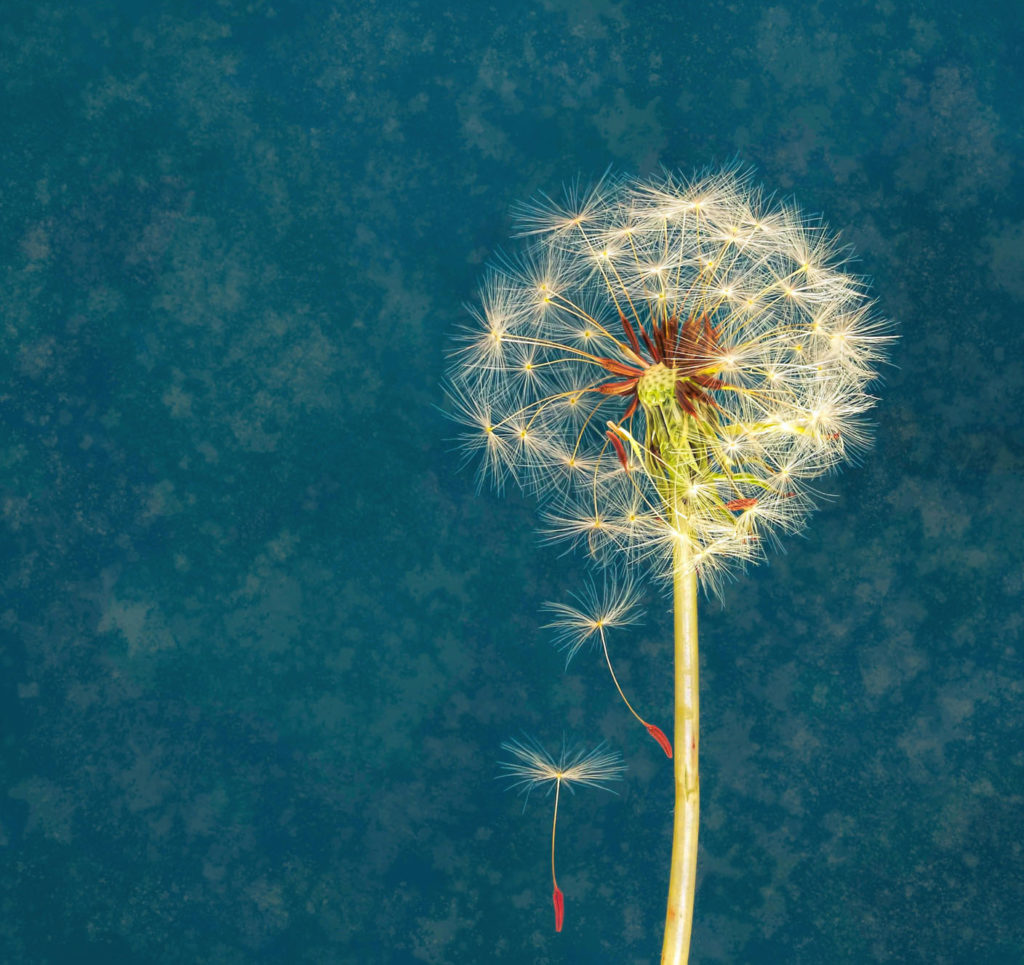
“We were like, ‘Well, what does that mean? Do we want Razorbacks? What is that, right?’” shares Jason Smith, exhibition project manager. “And we [determined] we just want a picture of what artists are doing right now in Northwest Arkansas — what they are creating in this time, here in this region. And that’s really what we were looking for.”
Thus, “Our Art, Our Region, Our Time” became the first exhibition in the venue’s history to put out a completely open call to artists in the area. Seventy-three pieces, by 64 artists, represent 16 cities in the WAC’s first regional visual arts exhibition. Kicking off the arts center’s 30th anniversary season with such a project is a testament to the institution’s commitment to supporting and reflecting the community it calls home.
“We could have easily gone out and picked 12 artists that we knew and had a brilliant show, but it wouldn’t have the same impact that this will have,” Smith says of the ambitious installation.
“And it’s just a drop in the bucket,” exhibition curator Kathy Thompson adds. “There are so many artists in this area. And that’s what we want people in our community and region to know, is we are so lucky to have so many creative people of all kinds, not just in the visual arts, but in our area, and we should be supporting them. That’s very important.”
In that spirit, “Our Art, Our Region, Our Time” is another in a long line of efforts the WAC has made to support local artists through pandemic-induced hardships. During covid, Smith explains, the staff took on a “community-based artists kind of mission,” organizing performance opportunities in nontraditional settings and getting musicians paid when gigs were scarce. Part of the purpose of the exhibition was to extend the same support to visual artists, and to get their work in front of Northwest Arkansas patrons, which is not always easy, Smith points out.
“And the full commission goes to the artist, which is never done. Unheard of,” Smith says of the works available for sale. “Besides the show, that’s the gift of the Walton Arts Center,” Thompson adds.
Among the 73 pieces chosen to fill the gallery space, the people and social communities that make up Northwest Arkansas are all there, the pair agree proudly. One of the only true criteria the selection committee was looking for, they reveal, were pieces that “make the viewer stop and think and ask questions.”
“The first word that comes to my mind is diversity,” Thompson says in thinking over the collection on display. “I mean, it’s not just the artists that are diverse, it’s not just the work is diverse. It’s the way we hung it. We tried to make it seem that way; we want people to come in and just go, ‘Wow!’”
“I think what Kathy did so beautifully was that she mixed them up in a way that it adds value to each piece that you come across,” Smith says of the exhibition’s layout. “Because it really kind of points out how different and how special each piece is, which you don’t always get when you go in and it’s all the same theme or all the same medium.”
The goal, Smith recalls Thompson saying during the installation process, is for the art to speak for itself. Only a visit to the Joy Pratt Markham Gallery can determine if the pieces do, so in the meantime, a few of the artists featured in “Our Art, Our Region, Our Time” offer a glimpse into their practice with a few sentiments of their own:
Marlie Allgood
marlieallgood.com, @marlieallgood on Instagram
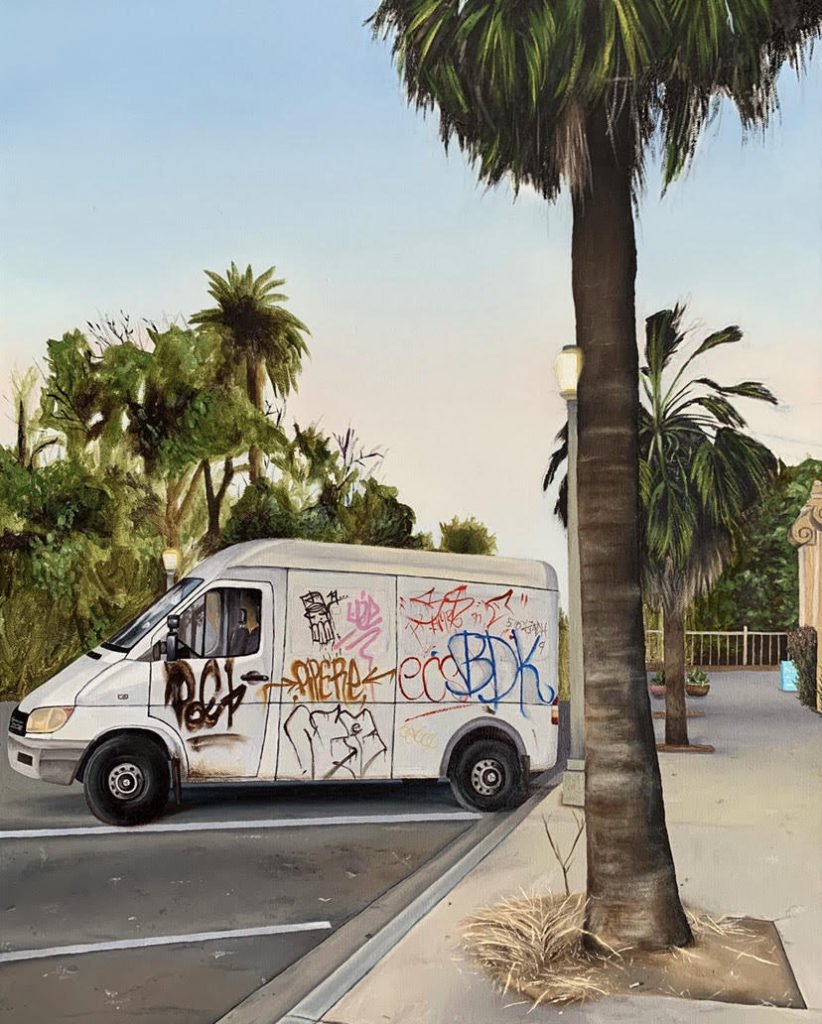
“The work included in this exhibition is a scene that means a lot to me personally. Before the pandemic, I was living in San Diego. This was my first real experience on my own and living in a new, large city. In many ways, this was the best but also most difficult time of my life. The scene painted here was an everyday view I saw on my walk into work that continued to capture my attention. There were probably 50 or so pictures of this van on my phone before I left, always in the same parking lot with new colors of spray paint. My work relies heavily on my attachment to places I’ve lived or memories of these places. Homes can often be a temporary experience, but my paintings allow me to document on my own time, with nostalgia and healing.”
Allgood was always interested in art from a young age, she reveals. “I’ve probably taken every art class possible, but it all clicked for me during college when I took my first oil painting class. Oil paint allows me to achieve smooth gradients of color while giving the time to work slowly and observe.”
In many ways, she says, painting is a way for her to decompress and focus her mind on a task. Of course, the aim is to finish paintings, but it’s fun to get lost in the process, Allgood admits. It was the encouragement from her family and art instructors that has always kept her going in her practice, but moving to Northwest Arkansas increased her support immeasurably.
“I’ve been able to surround myself with like-minded people who love art just as much as I do, which is essential for any artist to thrive. I am thankful to be here, and I’m looking forward to meeting and connecting with more people in the community.”
Neil Callander
neilcallander.com, @neil_callander on Instagram
“I have a long list of favorite paintings. Lately I’ve been returning to the paintings of the Italian Renaissance — the frescoes of Piero, Masaccio, Masolino and Giotto. The frescoes in particular feel like they were painted with the idea that the viewer would return over and over. Their complexity, visual poetry and range of emotion never disappoints.”
Callander packs his paintings with cultural and personal references. In his “Our Art,” piece, “Imagined Finn, Husky,” Callander created a portrait of his son that imagines him as a child that needs husky-sized clothes. “In actuality he is a stringbean,” he says.
“Individual paintings definitely have specific ideas attached to them,” he says. “Common to all the paintings is a desire to create something that holds the viewer, however momentarily, in thought and delight. And reminds them of what is timeless.”
Callander treats his paintings as objects as well as vehicles for information, he shares on his website. The edges of the canvas inform his compositions, reinforcing the flatness of the picture plane. Callander reveals that he wants the viewer to feel the reality of the surface through the pressure of the edges while also engaged in a tangible painterly space.
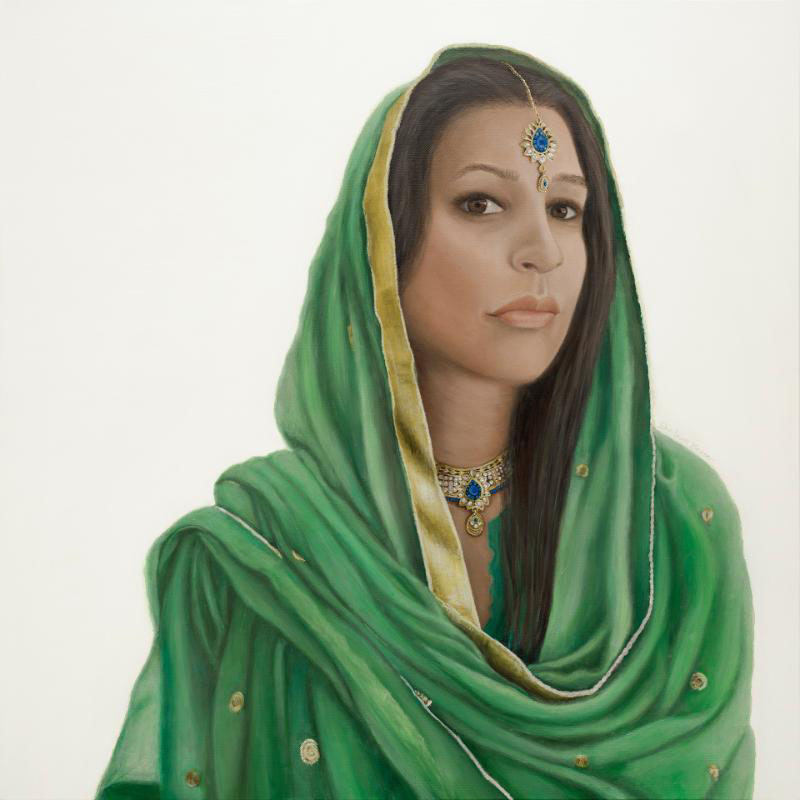
Shabana Kauser
shabanakauserart.com, @shabanakauserart on Instagram and Facebook
“Being a Pakistani woman in America, where I can express myself through my art, has been very powerful. Each one of the stories behind my work has a universal message of strength, courage, determination, uncertainty, belonging and acceptance. That resonates with people regardless of their gender or background,” Shabana Kauser says. “Our region has really amazed me with their interest in my culture and have been receptive to the desired result I had in my mind.
“I think it’s crucial for Pakistani women artists to exist. It’s especially important that young South Asian girls see someone with the same skin color as them in the art world. They need to realize at an early age that they can be future artists, there is a place for them. A visual representation of that is crucial. The art world needs authentic portraits of all backgrounds and cultures. After exhibiting my work in varies galleries and venues, this has opened up so much dialog in communities. That makes me realize the impact my work could have further down the road.”
Kauser’s creative muse came to her in Northwest Arkansas, she reveals. Kauser was born in the UK to Pakistani immigrant parents and lived there for 30 years before she and her husband transferred to Fayetteville. Due to visa restrictions, she found herself unable to work for several years and looked to her community and her interests in her search for fulfilment. Enrolling in an oil painting class through the Community Creative Center, Kauser had little expectation for herself, but found her passion for creating.
“I create oil paintings and mixed media abstract work. I enjoy switching from the mediums when creating. My oil paintings are representational, so I enjoy capturing details and sharing that with the viewer. … My other medium is mixed media work which includes using traditional South Asian fabrics, resin and acrylic paint as the core materials. … I loved the process, knowing I could just let go, make mistakes and learn from them. I allowed myself time and wastage of materials to be a part of the process. That’s where the ‘Shine’ series started. This year I have successfully exhibited my mixed media work in galleries in Northwest Arkansas and beyond.”
Monica McCleary
cirrostudio.com, @cirrostudio on Instagram

“I love how wood furniture is a functional piece of art. You can appreciate its natural beauty as well as interact with the actual piece, whether it’s sitting on a chair, or eating a meal with your family and friends at a table. What I also really enjoy about working with wood is how sustainable of a material it is. Wood furniture can last throughout many family generations, and can be refurbished over time. Whether you invest in handcrafted wood furniture or refurbish an older piece, you can make a difference in the environment by not contributing to the negative environmental effects by way of mass-produced furniture.”
McCleary’s furniture design approach is inspired by the Shaker style, as can be seen with her “Staked Bench” furniture piece on exhibit in “Our Art, Our Region, Our Time.” McCleary is also inspired by the Bauhaus movement and minimalist approach.
“The motto for my small furniture design and making studio is ‘made by hand, feel at home.’ With every piece I design and make, my desired result is for the owner of the piece to feel at home, at ease and at peace. We live in a culture cluttered with material objects, non-stop information, never-ending to-do lists, world issues, and so on. I want to help folks create a space at their home/office/business where they can feel like it is their sanctuary and ‘recharging station,’ if you will.”
McCleary is in the process of moving her home wood shop to downtown Rogers, where she will have a small storefront gallery, set to open in November. Visitors can purchase her handcrafted home goods, and McCleary also plans to offer workshops and community events at the gallery at 103 W. Chestnut St., Unit 101.
__
FAQ
‘Our Art, Our Region, Our Time’
WHEN — Through Nov. 5; gallery hours Monday-Friday 10 a.m. to 2 p.m. and one hour prior to most performances
WHERE — Walton Arts Center, 495 W. Dickson St. in Fayetteville
COST — Free, some works for sale; contact visualart@waltonartscenter.org for pricing
INFO — 443-5600; waltonartscenter.org/edu/visual-arts
FYI — Masks required to view exhibition; when visiting during a performance, proof of negative covid-19 test within 72 hours or proof of full vaccination is required for entry.
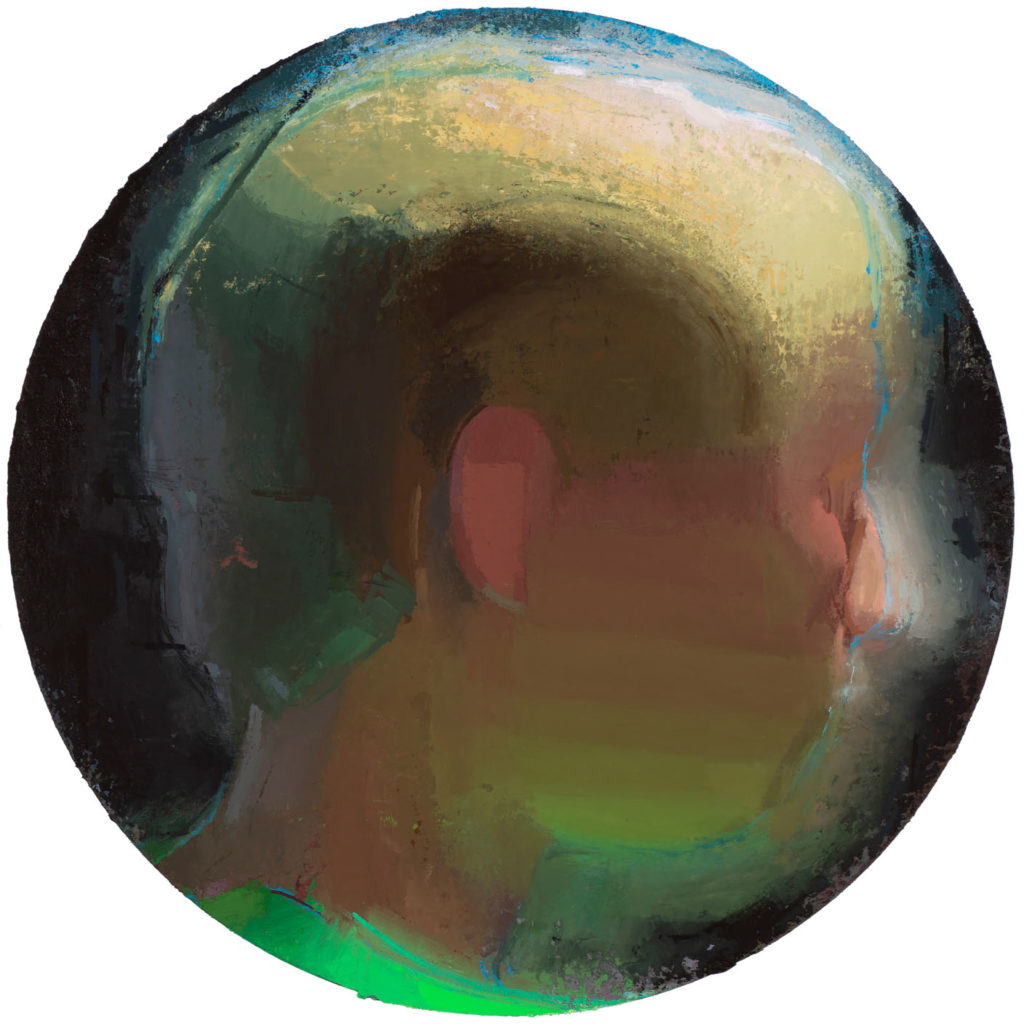
“Imagined Finn, Husky” by Neil Callander “I pack a painting with cultural and personal references and work toward an image that is provocative yet conceptually flexible,” artist Neil Callander shares in his artist statement. This oil on muslin piece imagines Callander’s son as a child that needs husky-sized clothes. “In actuality he is a stringbean.” (Courtesy Image/Neil Callander) 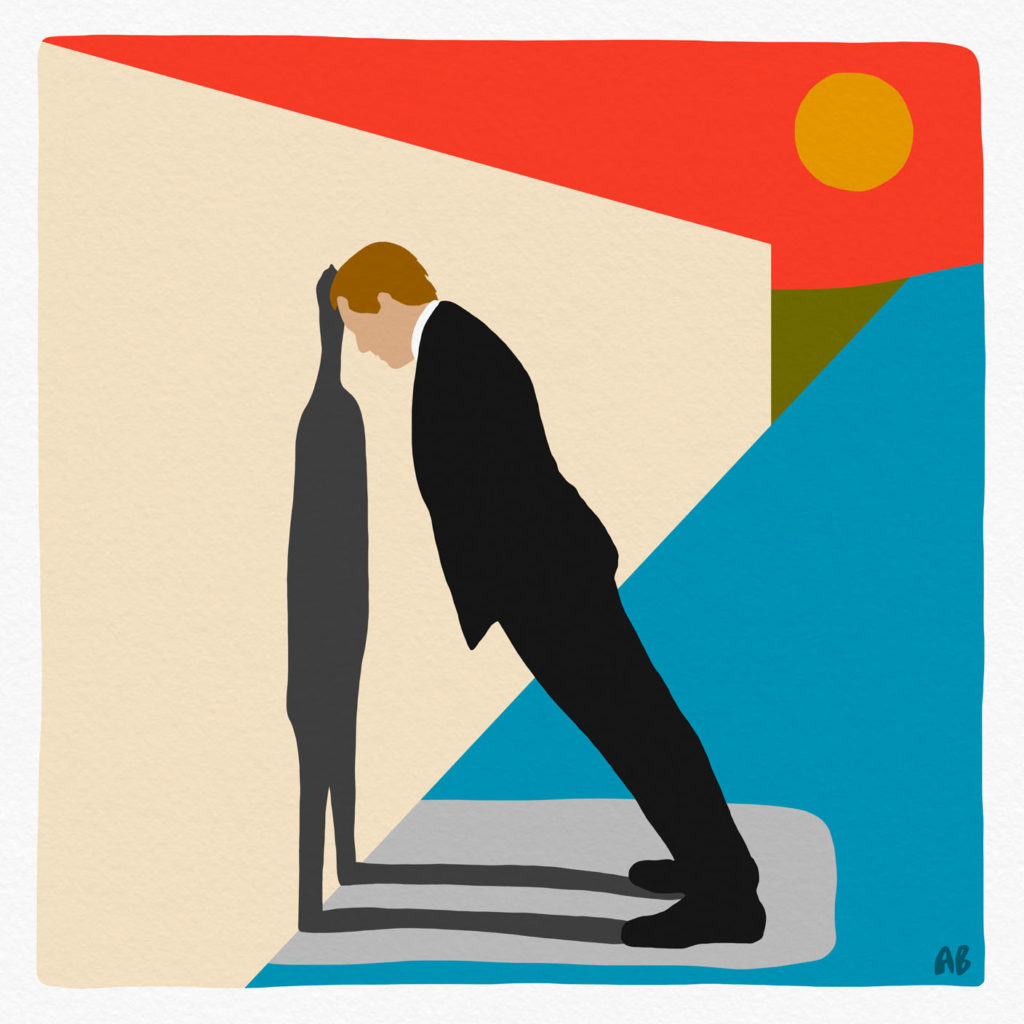
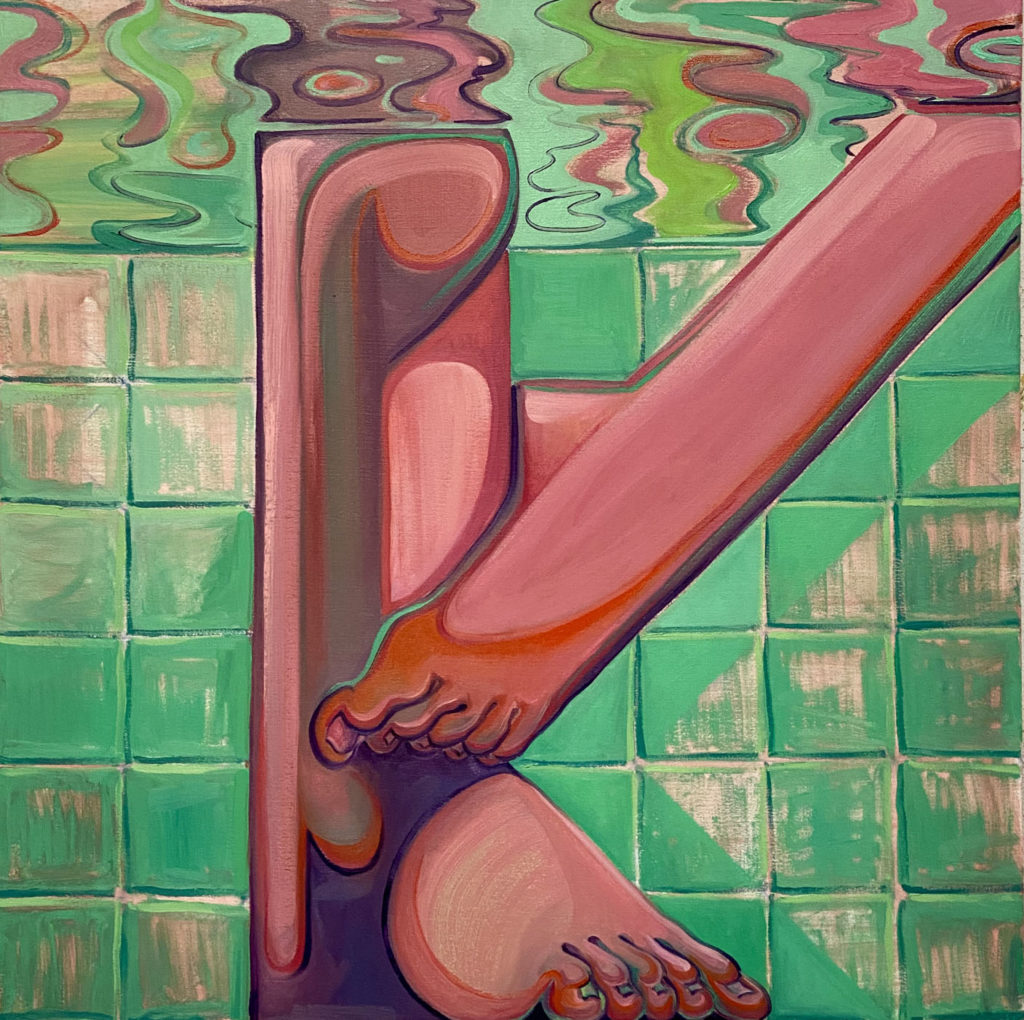

“Spanish Village” by Marlie Allgood “My work relies heavily on my attachment to places I’ve lived or memories of these places,” artist Marlie Allgood says of the scene depicted in her piece, which she encountered each day on her way to work. “Homes can often be a temporary experience, but my paintings allow me to document on my own time, with nostalgia and healing.” (Courtesy Image/Marlie Allgood)



